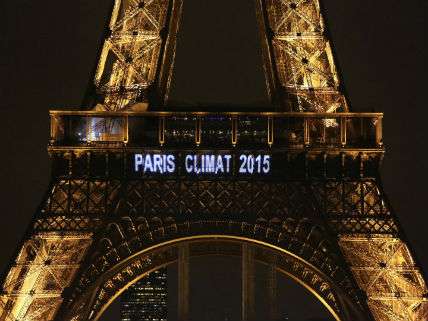Paris Climate Change Conference
Paris Climate Conference Emissions Promises Do NOT Mean Real Emissions Cuts
Sixth Dispatch: The claim that pledges from 180 countries cover 95 percent of emissions is seriously misleading.

Paris - Over the past 25 years of climate change negotiations, one of the chief objections to making commitments to cut greenhouses in the U.S. is that doing so would make no difference to the climate since other countries would merrily continue to burn fossil fuels and further load up the atmosphere with carbon dioxide. Two days ago at the Paris climate change conference, U.S. Secretary of State John Kerry sought to assure Americans that this time they will not be taken for chumps. How so?
"More than 180 countries – representing 95 percent of global emissions – have made individual commitments," declared Kerry at the Paris climate change conference. "That is a sign – and they made those commitments before they came here, the 180, now up to 186. But they came here and made a statement through the announcement of those determinations that they are determined, we are determined to succeed here in Paris." Hooray, right? Not so fast.
This formulation - 180 countries/95 percent - has become a ritual incantation constantly uttered throughout the particle board hallways and conference rooms here at the Le Bourget site. Negotiators and activist cite it as evidence that all countries are committed to adhering to a universal climate treaty. This is misleading.
Kerry is right that some 180 countries have submitted what are called their intended nationally determined contributions (INDCs). The INDCs are basically voluntary pledges from countries explaining what they plan to do to address the problem of global warming after 2020 when the new universal climate treaty comes into effect. For example, the Obama administration has promised to cut U.S. greenhouse gas emission by 2025 up to 28 percent below their 2005 levels. So all countries are in this together, right? Not so fast. Let's take a look what the INDCs of several major countries are promising to do by 2030.
In its INDC China, the world's largest emitter of greenhouse gases promises to peak its emissions by 2030, which means that it may well be emitting 60 percent more greenhouse gases. In its INDC the Indian government makes it clear that it intends to get electricity to the 300 million of its citizens who don't have access to it now. This means that India could triple its emissions by 2030. Russian emission could rise by as much as 50 percent by 2030. Indonesia's emissions are also slated to increase by 50 percent. In its INDC, Turkey forthrightly says that it will double its emissions. Iran's emissions will also double, but it will graciously accept $35 billion in aid to reduce that increase from 100 percent to 88 percent. Saudi Arabia promises that its emissions will only increase by 158 percent.
The INDCs submitted prior to the Paris climate change conference do indeed cover 95 percent of global emissions. But just ones listed above show that countries responsible for 44 percent of current global emissions have no intention of making actual cuts in their emissions over the next 15 years. In fact, if these countries follow the emissions trajectories outlined in their INDCs, they collectively will be emitting nearly 14 gigatons more carbon dioxide than they do now. That is double the amount that the U.S. currently emits.
Of course, what Kerry and other representatives from rich country governments are hoping is that by getting these countries to adopt the new Paris climate agreement that they can be persuaded down the road to make faster and deeper cuts. Well, maybe.
Note: I am filing daily dispatches from the Paris climate conference. We have been told that the really final universal climate accord will be agreed upon early on Satuday morning.


Show Comments (106)